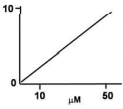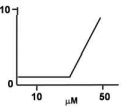 Multiple Choice Questions
Multiple Choice QuestionsA researcher wants to obtain complete chemical information, i.e. head groups and fatty acids of phospholipids from liver tissues. Phospholipids have fatty acids of different lengths and unsaturation and also the head groups are of different chemistries. Which of the following combination of techniques would provide complete chemical description of phospholipids?
Only thin layer chromatography (TLC)
TLC and gas chromatography
Paper and thin layer chromatography
Only paper chromatography
It is hypothesized that the mean (μ0) dry weight of a female in a Drosophila population is 4.5 mg. In a sample of 16 female with = 4.8 mg and s = 0.8 mg, what dry weight values would lead to rejection of the null hypothesis at p = 0.05 level? (take t0.05 = 2.1)
Values lower than 4.0 and values higher than 5.6.
Values lower than 3.20 and values higher than 6.40.
Values lower than 4.38 and values higher than 5.22.
Values lower than 3.22 and values higher than 6.48.
Radioimmunoassay (RIA) can be employed for the detected of insulin in blood plasma. For this, 125I-labelled insulin is mixed and allowed to bind with a known concentration of anti-insulin antibody. A known volume of patients blood plasma is then added to the conjugate and allowed to compete with the antigen binding sites of antibody. The bound antigen is then separated from unbound ones and the radioactivity of free antigen is then measured by gamma counter. Following are some of the statements made about this assay.
(i) The ratio of radioactive count for unbound antigen to the bound one is more at the end of reaction.
(ii) The ratio of radioactive count for unbound antigen to the bound one is less at the end of reaction.
(iii) For a diabetic patient, the radioactive count for free antigen is less than that for a normal individual.
(iv) For a diabetic patient, the radioactive count for free antigen is more than that for a normal individual.
Which of the above statements are true?
(i) and (iii)
(i) and (iv)
(ii) and (iii)
(ii) and (iv)
From statements on protein structure and interactions detailed below, indicate the correct statement.
The concentration of a tryptophan-containing protein can be determined by monitoring the fluorescence spectrum of the protein.
A peptide with an equal number of Glu and Lys amino acids can show multiple charged species in its electrospray ionization mass spectrum.
The circular dichroism spectrum of a protein shows predominantly helical conformation. Analysis of its two dimensional NMR spectrum shows predominantly β-structure.
Binding constant can be determined by two interacting molecules by the technique of surface plasma resonance only if there is strong hydrophobic interactions between them.
The sequence of the peptide KGLITRTGLIKR can be unequivocally determined by
Only Edman degradation
Amino acid analysis and MALDI MS/ MS mass spectrometry
MALDI MS/ MS mass spectrometry
MALDI mass spectrometry after-treatment of the peptide with trypsin.
In a typical gene cloning experiment, by mistake a researcher introduced the DNA of interest within ampicillin resistant gene instead of lac z gene. The competent cells were allowed to take up the plasmid and then platedin the media containing ampicillin, X-gal and IPTG and subjected to blue-white screening. Considering all plasmids were recombinant which one of the following statements correctly describes the outcome of the experiment?
The bacteria which took up the plasmids would grow and give blue colonies.
The bacteria which took up the plasmids would not grow.
The bacteria which took up the plasmids would form white colonies.
All of the bacteria would grow and give white colonies.
In an effort to produce gene knockout mice, a gene-targeted homologous recombination was tried with the exogenous DNA containing neor gene (confer G-418 resistance) and toHsv gene (confers sensitivity to the cytotoxic nucleotide analog ganciclovir). If the neor gene was inserted within the target gene in the exogenous DNA and considering that both homologous and non-homologous recombination (random integration) is taking place, which one of the following statements is NOT correct about the possible outcome of the experiment?
Cells with non-homologous insertion will be sensitive to ganciclovir.
None-recombinant cells will be sensitive towards G-418 and resistant to ganciclovir.
Homologous recombination will ensure that cells will be resistant to both ganciclovir and G-418.
Homologous recombinants will grow in G-418 containing media but will be sensitive towards ganciclovir.
D.
Homologous recombinants will grow in G-418 containing media but will be sensitive towards ganciclovir.
Among the give options, statement 4 is the possible outcome of the experiment.
Molecular polmorphic markers are already known with respect to tobacco mosaic virus (TMV) resistance in tobacco. Among these, which marker system you will select that will be simple, economic and less time consuming:
RAPD
RFLP
AFLP
EST-SSR
Performance of biosensor is evaluated by their response to the presence of an analyte. The physiological relevant concentration of analyte is between 10μM and 50μM. Which among the following biosensor responses is best?




One hundered independent populations of Drosophila are established with 10 individuals in each population, of which, one individual is of Aa genotype and the other nine are of AA genotype. If random genetic drift is the only mechanism acting on these populations, then, after a large number of generations, the expected number of populations fixed for the "a" allele is
75
50
25
5
